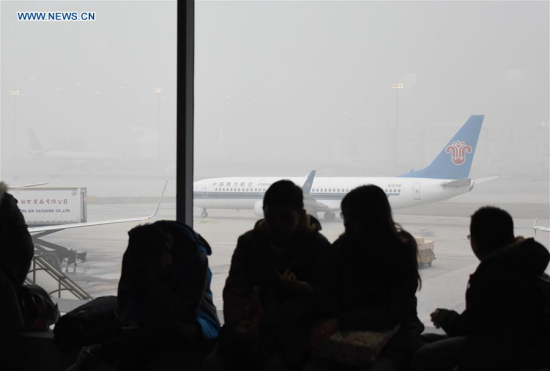
Passengers wait at Beijing Capital Airport in Beijing, capital of China, Dec. 25, 2015. Some flights were delayed due to the orange alert smog on Friday. (Xinhua)
Many Beijing residents might not have been surprised by their Christmas gifts on Friday morning, but they were shocked by a heavy layer of smog that descended unexpectedly on the city.
Beijing issued a blue alert for pollution on Thursday, but upgraded it to yellow on Friday. China has a four-tier warning system, with red as the most severe, followed by orange, yellow and blue.
The experts said unfavorable weather and pollutant emissions had led to rapid degradation of air quality in Beijing since Thursday.
The general air quality index readings in Beijing reached 500 by Friday noon. PM2.5 stood at an average of 477 micrograms per cubic meter as of 8 p.m., data from Beijing Municipal Environmental Monitoring Center (BMEMC) showed.
Beijing Education Committee issued an urgent notice calling for kindergartens, primary schools and middle schools to restrict outdoor activities.
More than 220 flights at Beijing's Capital International Airport were canceled due to poor visibility.
The Ministry of Environmental Protection called an expert meeting on Friday to discuss the response to the pollution in 70 northern and central cities.
Beijing and eight other cities including Jinan and Dongying in Shandong Province reported the highest level of pollution, and another 16 cities experienced "heavy" pollution, according to the environment ministry. Shanghai and Wuhan also went on the alert on Friday as air from the north reduced the visibility to as low as 500 meters.
Experts predict relief from Saturday noon as a cold front disperses the smog. On Sunday, the air quality will be good or indicate only light pollution in Beijing, and pollution should also drop in most cities of the Beijing-Tianjin-Hebei area, but heavy pollution could linger in some parts.
Roughly 50 cities in northern and eastern China have issued air pollution alerts in the most recent bout of smog. Beijing was on red alert from Dec. 19 to 22, the second in December, limiting vehicles on roads and banning fireworks and outdoor barbecue.
Emergency measures cut PM2.5 density in Beijing by 20 to 25 percent during the second red alert, said Zhang Dawei, director with BMEMC.
Actually, the city's density of PM 2.5 averaged 74 microgrammes per cubic meter in the first 11 months this year, down by 16.6 percent from last year.
The improvement is perhaps due to limiting emissions, favorable weather conditions and cleaner production. Xia Yi, an official with Beijing development and reform commission, said the city used 11 million tonnes less coal than three years ago, roughly halving the amount burned.
An emergency plan for Beijing, Tianjin and Hebei Province is currently out for public opinion, aiming to coordinate the smog response of Beijing, Baoding, Cangzhou, Langfang, Tangshan and Tianjin.
Zhang Gong, Beijing's deputy mayor, revealed that these cities plan to adopt the strictest measures simultaneously when heavy pollution threatens.


















































